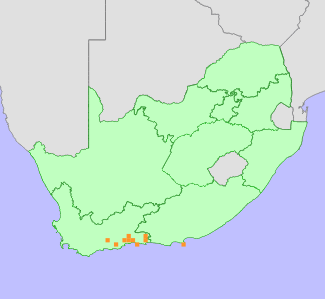Goldblatt, P. and Manning, J.C. 2000. Cape Plants: A conspectus of the Cape Flora of South Africa. Strelitzia 9. National Botanical Institute, Cape Town.
Hall, A.V. 1965. Studies in the South African species of Eulophia. Journal of South African Botany Supplement 5:1-248.
Hall, A.V., De Winter, M., De Winter, B. and Van Oosterhout, S.A.M. 1980. Threatened plants of southern Africa. South African National Scienctific Programmes Report 45. CSIR, Pretoria.
Hilton-Taylor, C. 1996. Red data list of southern African plants. Strelitzia 4. South African National Botanical Institute, Pretoria.
Johnson, S. and Bytebier, B. 2015. Orchids of South Africa: A field guide. Struik Nature, Cape Town.
Liltved, W.R. and Johnson, S.D. Unpublished. The Cape Orchids - Wild orchids of the Cape Floral Kingdom.
Linder, H.P. and Kurzweil, H. 1999. Orchids of southern Africa. A.A. Balkema, Rotterdam.
Raimondo, D., von Staden, L., Foden, W., Victor, J.E., Helme, N.A., Turner, R.C., Kamundi, D.A. and Manyama, P.A. 2009. Red List of South African Plants. Strelitzia 25. South African National Biodiversity Institute, Pretoria.
Victor, J.E. 2002. South Africa. In: J.S. Golding (ed), Southern African plant Red Data Lists. Southern African Botanical Diversity Network Report 14 (pp. 93-120), SABONET, Pretoria.
Victor, J.E. and Dold, A.P. 2003. Threatened plants of the Albany Centre of Floristic Endemism, South Africa. South African Journal of Science 99:437-446.
Vlok, J. and Schutte-Vlok, A.L. 2010. Plants of the Klein Karoo. Umdaus Press, Hatfield.
|
 Comment on this assessment
Comment on this assessment


